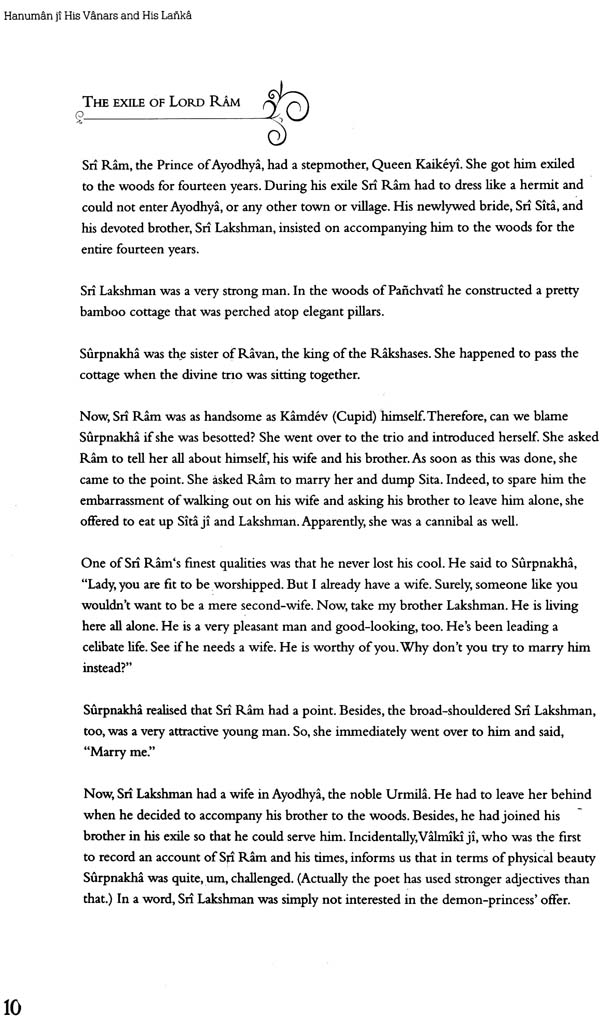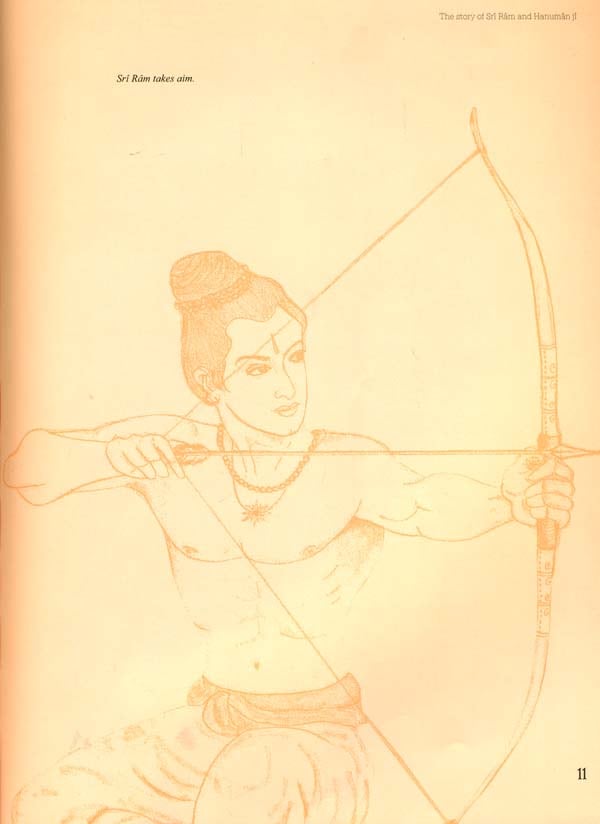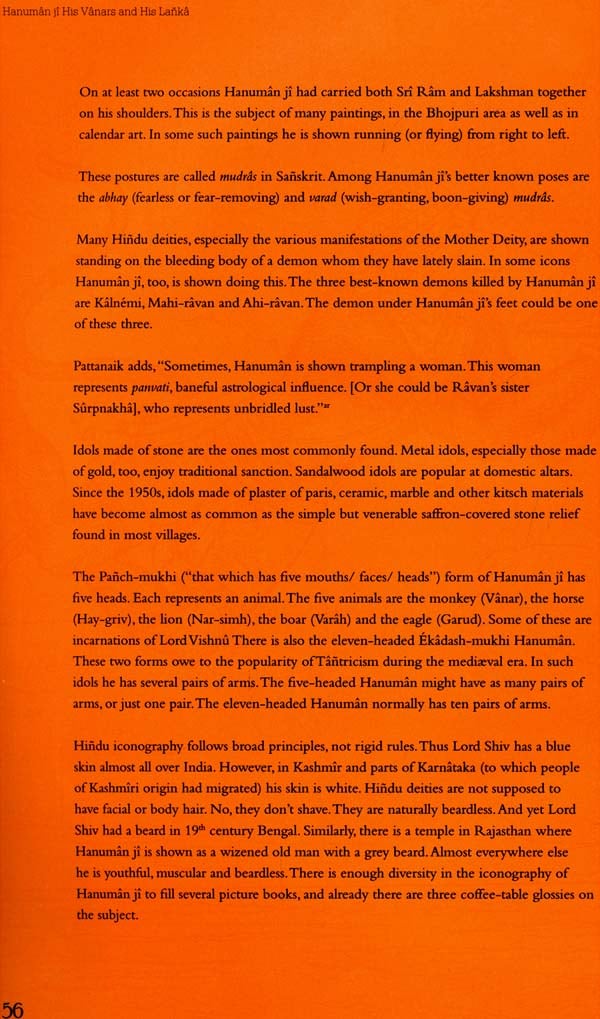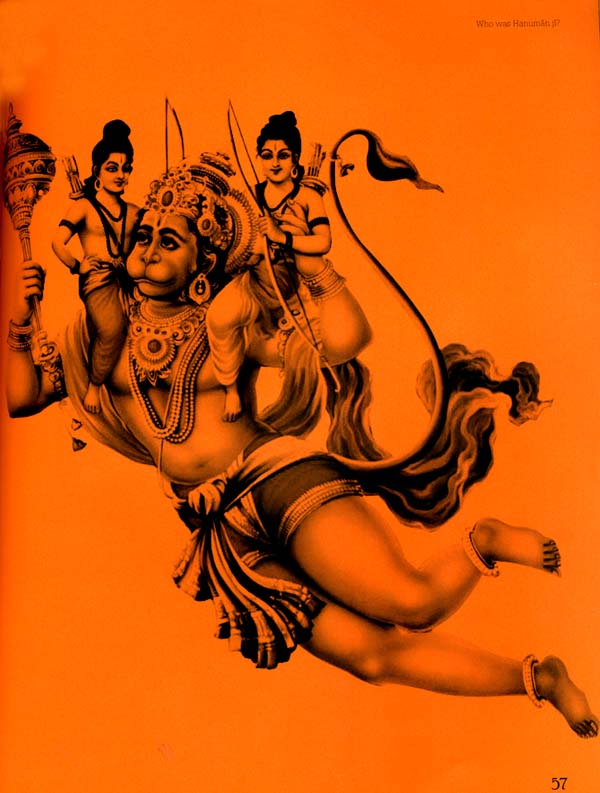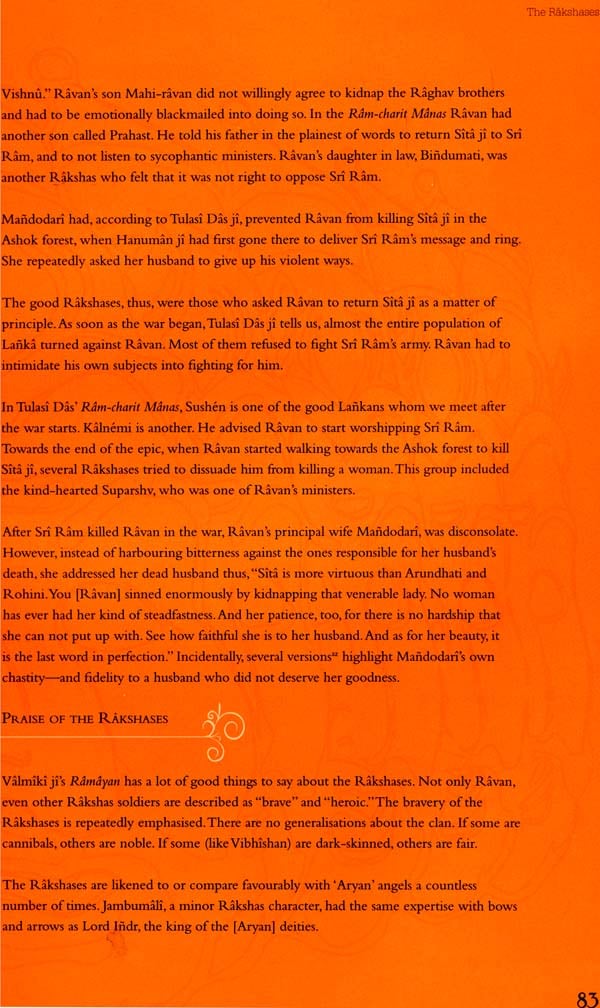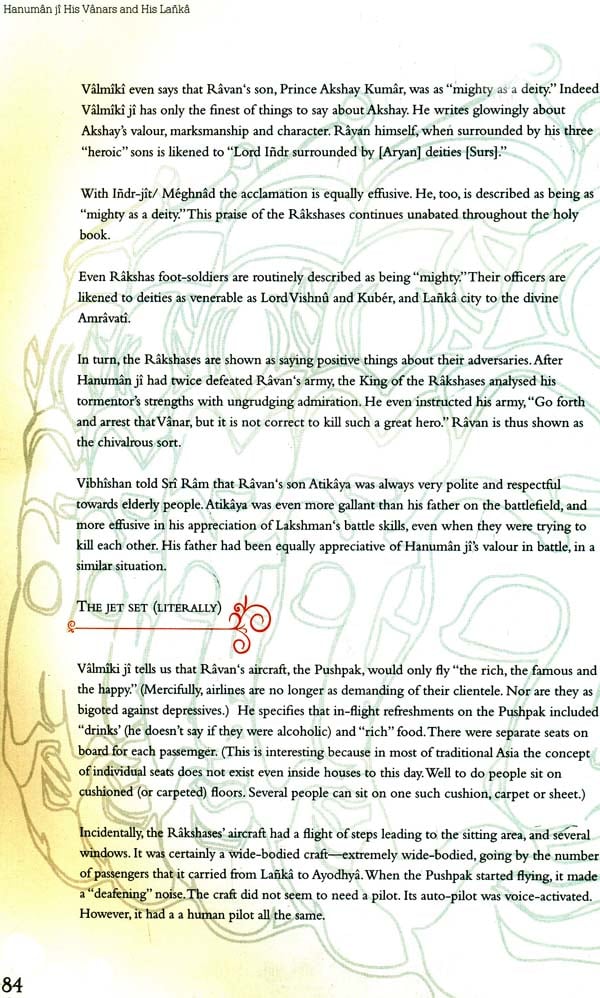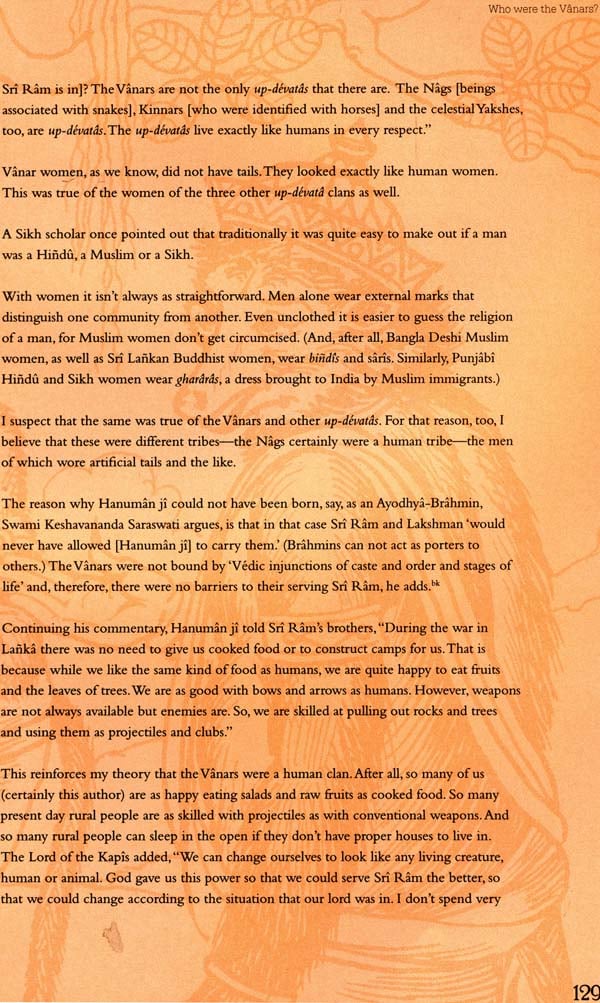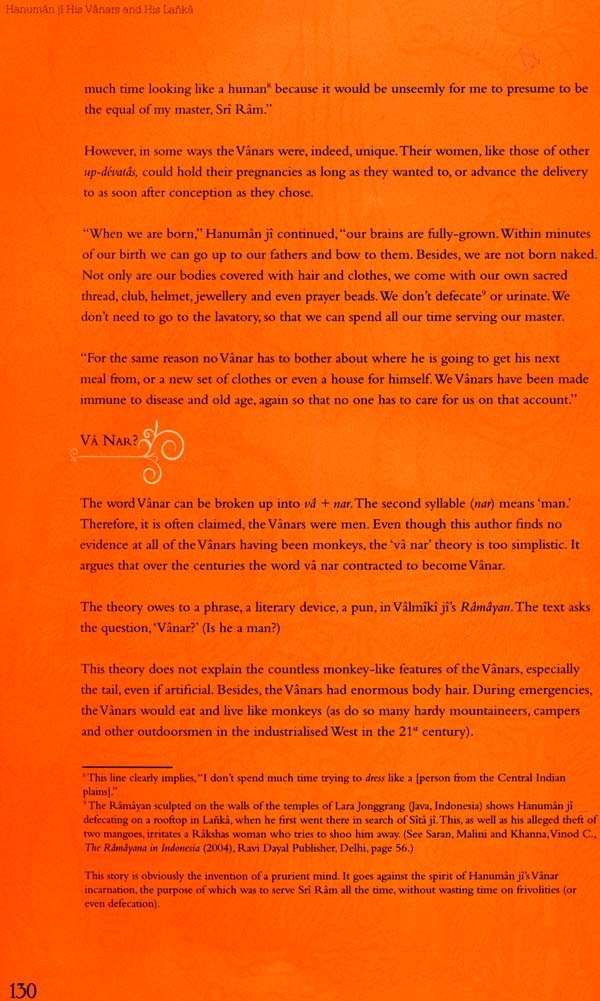
Hanuman Ji (His Vanars and His Lanka)
Book Specification
| Item Code: | IHJ088 |
| Author: | Parvez Dewan |
| Publisher: | Shubhi Publications |
| Edition: | 2006 |
| ISBN: | 8182902010 |
| Pages: | 139 (Illustrated Throughout In Full B/W |
| Cover: | Hardcover |
| Other Details | 12.0 inch X 8.5 inch |
| Weight | 350 gm |
Book Description
The story of Sri Ram an Hanuman Ji has been subjected to much distortion and malign political abuse.
During the British Raj mainly in the 1800s divisive were floated to the effect that the north Indians were Aryans and the south Indians and Sri Lankans were Dravidians. The story of Sri Ram The Ramayan was sought to be shown as a conflict between the two the Vanars were portrayed as a primitive if not as monkeys.
In view of the mistreatment of the Ramayan this book asks.
Who was Hanuman Ji? Who were the Vanars? Were they monkeys? Or were they a primitive tribe? Or neither? Where was kishkindha? In Karnataka? Where was Ravan’s Lanka? It is the same as modern Sri Lanka who were the Rakshases were they what we now call Dravidians? Did they speak a Dravidian language were they all evil id nor demonic as well were they dark skinned and what kind of a person was Ravan the king of eh Rakshas clan?.
Ours is not a revisionist version of the story of Shri ram and his devotee Hanuman Ji indeed it is accounts that deviate form Valmkiji’s Ramayan that are.
Sri Ram is the most popular deity among the Hindus Hanuman Ji is his gates devotee and also the keeper of the gates that lead to Sri Ram. The devout believe that the only way to reach Sri Ram is through Hanuman Ji. That Hanuman ji and the Vanars were monkeys is a belief that has been with the Hindus at the folk level for centuries perhaps for more than three thousand years.
This Books Asks:
1) Who was hanuman ji? Was he a person given t deep reasoning or a simple monkey like creature? Beliefs about a deity who might have been Hanuman ji have been traced to the earliest Hindu scriptures the Rig Ved Downwards.
2) Who were the Vanars? If they were monkeys how come their women looked like Human women and did not have tails? Were the tails of the male Vanars mere ornaments?
3) Where was Kishikindha? Most devout Hindus believe that it was in present day Karnataka but the original Ramayan says that it was north of the Vindhya Range of hills.
4) Where was Ravan’s Lanka’s? Was it the same as modern Sri Lanka? All the Ramayans say that it was southwest of India and a hundred yojans from the nearest peninsular shore.
5) Who were the Rakshases? If they were Dravidians and the Dravidians are a linguistic group not a race why did they not speak a Dravidian Language? 6) What kind of person was Ravan the king of the Rakshas clan? He had in the past too abducted women and married them. This book at the good as well as within him.
Parvez Dewan can send you to sleep about Hanuman Ji. After translating into English verse the hanuman Chalisa of Goswami Tulsi Das with a commentary on each verse of that noble prayer book he wrote the book of Hanuman (2004, Viking Penguin) which summarized the story of Sri Ram’s principles lieutenant as told in Valmiki ji’s Ramayan.
Parvez has also put together a detailed biography of Hanuman ji based on the various Ramayans of India South east Asia Tibet and East Asia.
Parvez was educated at St Stephen’s college Delhi and the university of Cambridge and was later elected a visiting research fellow of Queen Elizabeth house Oxford.
At St Stephen’s he was the president of the college Union society and was awarded the L. Raghubir Singh History Prize for ranking first in his BA (Hons) class at Cambridge he won the Jennings prize in 1987 for obtaining in the developing studies class. He was the senior Treasurer of the C.U (Cambridge university) friends of the earth and was also active with the C.U green party and the C.U Mystics.
Parvez is an officer of the Jammu & Kashmir cadre of the Indian Administrative service.
| The Story of Sri Ram and Hanuman Ji | 9 |
| The Exile of Lord Ram | 10 |
| The Abduction of Sri Sita Ji | 13 |
| Was Jatayu a Bird? | 16 |
| Sri Ram and Lakshman look for Sita Ji | 16 |
| The issue covered by this book | 19 |
| Who Was Hanuman Ji? | 21 |
| The Rig Ved and the Brahm Puran Vrishakapi | 22 |
| Hanuman ji in the Veds: claims made by secondary sources | 24 |
| Hanuman Ji some important dates | 25 |
| How when and why Hanuman ji is worshipped | 28 |
| What do devotees pray to Hanuman Ji for? | 30 |
| What Hanuman Ji stands for | 37 |
| Hanuman ji turns the tide of events | 38 |
| The Master of senses | 41 |
| What Hanuman ji Symbolizes/ A spiritual interpretation of the story of Ram | 41 |
| Vayu the symbol of selflessness | 44 |
| Hanuman ji relationship with Sri Ram as viewed by different scholars | 47 |
| The only perfect Sanyasi | 47 |
| The Qualities of Hanuman Ji | 47 |
| Responsibilities towards mankind | 47 |
| A Bridge between denominations | 48 |
| Hanuman Ji’s relative importance | 48 |
| Hanuman Ji as an ally of Ravan! | 50 |
| Iconography | 50 |
| How idols of Hanuman Ji should be installed | 59 |
| Famous temples | 59 |
| Women | 62 |
| Lanka The Rakshases and Ravan | 63 |
| 1. The evidence of the valmiki Ramayan | 66 |
| Was the Lanka of the Ramayan the same as Sri Lanka? | 66 |
| Location | 66 |
| Geography | 66 |
| Vegetation | 67 |
| Sacred Trees | 67 |
| Lanka was in a Seismic Zone | 67 |
| 2. The Evidence of other sources | 68 |
| Was Lanka a land of savages? | 73 |
| Technology | 74 |
| Affluence | 74 |
| Architecture | 74 |
| The Rakshases | 79 |
| Is Rakshas a generic word? | 80 |
| Were all Rakshases evil? | 80 |
| Praise of the Rakshases | 83 |
| The Jet set (Literally) | 84 |
| Culture | 88 |
| Intelligence | 88 |
| The Sciences | 88 |
| Black magic | 88 |
| Cannibals? | 88 |
| Were the Rakshases Non- Aryans? | 89 |
| Brahmin Rakshases | 90 |
| People are not born Rakshas | 90 |
| Their physical Features | 91 |
| A cosmopolitan population | 91 |
| Matrimonial Relations | 91 |
| The Same deities the same faith | 91 |
| Sanskrit names | 93 |
| Sita ji and Vibhishan and Called unarya | 93 |
| Ravan | 95 |
| Was Ravan all evil? | 96 |
| Negative | 96 |
| The Stud | 96 |
| His physique | 96 |
| His ancestry (and that of the other Rakshases) | 98 |
| Sri Ram praises Ravan | 101 |
| His learning and his caste | 101 |
| The Kshatriya Ravan | 101 |
| Ravan and Vedic Rituals | 101 |
| Who were the Vanars? | 103 |
| 1. The evidence of the Valmiki Ramayan | 104 |
| Were they monkeys? | 104 |
| Their rituals the coronation of sugriv | 107 |
| Customs | 108 |
| Political institutions | 108 |
| Social stratification | 108 |
| Town planning and architecture Kishkindha the Vanars capital | 108 |
| The Vanars palace | 110 |
| The Royal vehicle | 110 |
| Their bodies | 110 |
| Their Clothes | 111 |
| Intelligence and scholarship | 111 |
| The Clincher | 113 |
| Food Habits were they vegetarians? | 113 |
| Were the Vanars Dravidians? | 114 |
| The Unarya Sugriv | 117 |
| Language | 117 |
| Names | 117 |
| Race/color of skin | 118 |
| Were they merely a different ethnic group? | 118 |
| Were the Vanars at least south Indians? | 121 |
| At the very least did sugriv’s clan live in south India? | 122 |
| 2. The Evidence of sources other than Valmiki Ji | 125 |
| Va Nar? | 130 |
| Glossary | 133 |
| Bibliography | 136 |
| Index | 137 |
